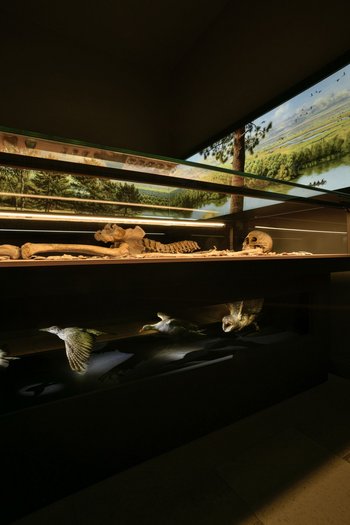Human succession
The ›shaman‹ from Bad Dürrenberg
Forest age
The second room in the ›Human Succession‹ section of the State Museum of Prehistory is dark and concealed. Impressively staged, here a profound climatic and natural change can be experienced – the bright expanses of the cold-age tundra give way to the shady mixed oak forests with many hazel and pine trees of the Middle Stone Age (Mesolithic). The reason for this were the steadily rising temperatures around 11,500 years ago. The last glacial period came to an end and a warm stage which continues to this day began. But with the decline of the open landscapes of the Ice Age also the large herds of reindeer and horses, which were abundant sources of food for humans, disappeared. Once again, people had to adapt their survival strategies and behaviour – tundra hunters became forest rangers and fishers.
A powerful woman
In the shade of the forest there is space for encounters of a special kind. The 30 to 40-year-old woman was buried bedded in raddle around 9,000 years ago. The lavish inventory of grave goods attests to a special social role of the deceased. The enormous diversity of animal species represented in the grave, of which not all would have been just food supplies for the afterlife, is remarkable. Ethnographic comparisons suggest that some objects are to be interpreted as requisites of shamanistic practices. The transition from mobile foraging to the sedentary way of life, caused by the immigration of farmers and cattle breeders to our region, marked the end of the Mesolithic around 5400 BC. The age of the hunter-gatherers – as the longest phase of the human lifestyle – came to an end.
The ›shaman‹ of Bad Dürrenberg is the subject of several Archaeofilm features. In the series ›Museum exklusiv‹, the films ›Das Grab der Schamanin von Bad Dürrenberg‹ and ›Eine mächtige Frau: die Schamanin im Landesmuseum‹ (both in German only) deal with our knowledge of the shaman as presented to you during your visit to the museum. In our new film series ›Archaeology exclusive‹, on the other hand, we present the results of the latest research on the ›shaman‹ since 2019. These films have English subtitles.
The ›shaman's‹ grave
The grave of the Bad Dürrenberg ›shaman‹ is one of the oldest burials in central Germany. An infant was buried with her. The analysis of the woman's skeleton revealed that her two uppermost cervical vertebrae were malformed and theat blood vessels in the lower skull area could have been spatially restricted. This malformation may have made her a special person. Anthropologists suspect that by holding her head in a certain position, she was able to clamp off a blood vessel. This possibly led to an involuntary eye movement, a so-called nystagmus. The overabundant inventory of grave goods alone testifies to a special social role of the deceased. Certain grave goods also played an important role in interpreting this burial as a shaman’s grave.





